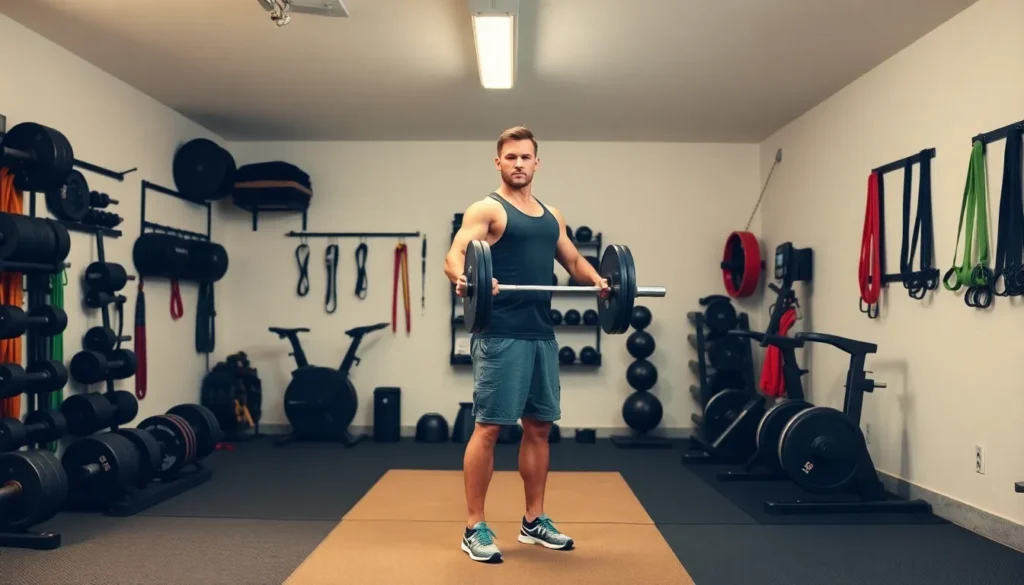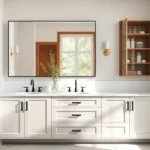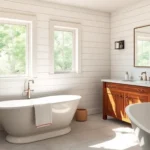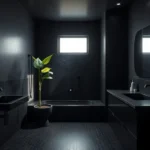We’ve all been there – staring at expensive gym memberships while dreaming of the convenience of working out at home. Creating your own home gym isn’t just about saving money; it’s about building a personalized fitness space that fits your lifestyle and goals perfectly.
The beauty of a home gym lies in its flexibility. Whether you’re working with a spare bedroom, garage or just a corner of your living room, we’ll show you how to maximize every square foot. From budget-friendly setups under $500 to premium home gyms that rival commercial facilities, there’s a solution for every space and budget.
Transform any area into your fitness sanctuary – and we’re here to guide you through every step. Let’s explore the most effective home gym setups that’ll keep you motivated and help you achieve your fitness goals without ever leaving your house.
Essential Equipment for Creating Your Home Gym Foundation
Building a solid foundation starts with selecting versatile equipment that maximizes your workout potential while fitting your available space.
Free Weights and Dumbbells
Adjustable dumbbells provide the most bang for your buck when setting up your home gym foundation. We recommend starting with a set that ranges from 5 to 50 pounds per dumbbell, which covers most strength training needs for beginners and intermediate users.
Kettlebells offer ever-changing workout options that combine strength and cardio training. A 15-pound kettlebell works well for women starting out, while men typically begin with 25-35 pounds. These cast iron tools excel at functional movements like swings, Turkish get-ups, and goblet squats.
Olympic barbells create opportunities for serious strength building when you’re ready to advance. Standard Olympic bars weigh 45 pounds and accommodate weight plates ranging from 2.5 to 45 pounds each. We suggest starting with 135 pounds total weight (bar plus plates) for most compound movements.
Weight plates in various denominations allow progressive overload training. Bumper plates protect your floors during deadlifts and Olympic lifts, while iron plates cost less and take up minimal storage space. A basic set includes pairs of 10, 25, and 45-pound plates.
Resistance Bands and Suspension Trainers
Loop resistance bands deliver targeted muscle activation for warm-ups and rehabilitation exercises. These compact tools come in light, medium, and heavy resistance levels, with many sets including all three options. We use them for glute activation, shoulder stability work, and travel workouts.
Tube resistance bands with handles replace an entire cable machine system at a fraction of the cost. Quality sets include door anchors, ankle straps, and multiple resistance levels from 10 to 50 pounds per band. They’re perfect for rows, chest presses, and lateral raises.
Suspension trainers like TRX systems provide bodyweight resistance training using your own weight as load. These systems anchor to doors, ceiling mounts, or outdoor structures, making them incredibly versatile. We can perform over 300 exercises using just one suspension trainer.
Power bands (also called loop bands) enhance lower body workouts significantly. These thick rubber bands range from light to extra heavy resistance and excel at hip abduction exercises, monster walks, and squat variations. Physical therapists frequently recommend them for injury prevention.
Cardio Equipment Options
Treadmills remain the gold standard for indoor cardio when space and budget allow. Folding models save floor space while offering speeds up to 12 mph and inclines reaching 15 percent. We recommend motors with at least 2.5 continuous horsepower for durability.
Stationary bikes provide low impact cardio that’s easier on joints than running. Spin bikes offer more intense workouts with adjustable resistance, while recumbent bikes provide back support for users with mobility concerns. Both options typically cost less than treadmills.
Rowing machines deliver full body cardio workouts that engage 85 percent of your muscles. Air resistance rowers like the Concept2 Model D provide smooth, natural motion and fold vertically for storage. These machines burn approximately 400-600 calories per hour.
Jump ropes cost under $20 but provide incredibly effective cardio training. We can burn 10-16 calories per minute with proper technique, making it more efficient than most other cardio options. Weighted ropes add upper body engagement to the traditional jump rope workout.
Space-Saving Home Gym Setup Ideas for Small Areas
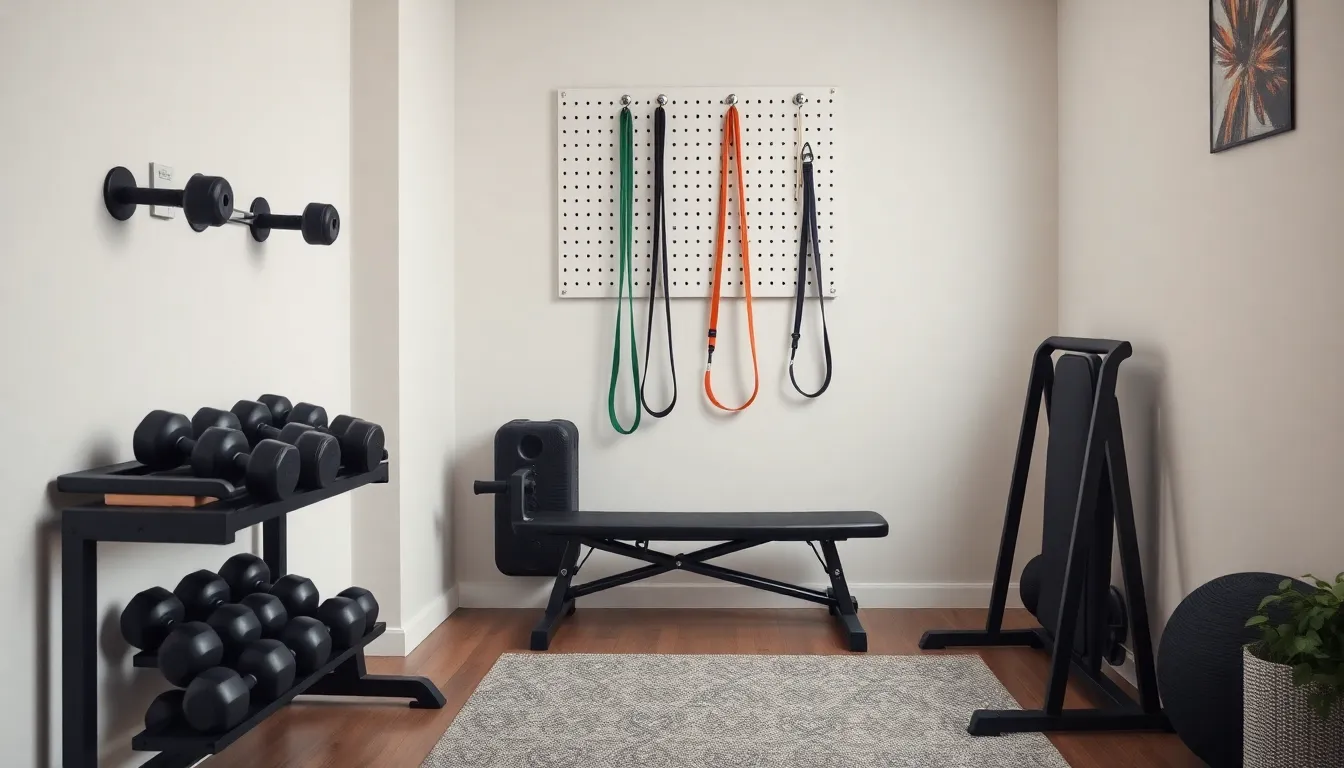
We understand that not everyone has a dedicated room for fitness equipment. Maximizing small spaces requires strategic planning and smart equipment choices that deliver results without overwhelming your living area.
Foldable and Compact Equipment Answers
Adjustable dumbbells transform your strength training routine by replacing entire weight sets with a single compact system. These space-saving tools adjust from 5 to 50 pounds per dumbbell, eliminating the need for multiple weight pairs that consume valuable floor space.
Resistance bands offer tremendous versatility in a package smaller than a shoebox. We recommend loop bands, tube bands with handles, and mini bands that provide variable resistance levels for strength training, rehabilitation, and mobility work.
Foldable workout benches store vertically against walls or slide under beds when not in use. Modern designs support up to 800 pounds while folding to just 6 inches thick, making them perfect for apartments and small homes.
Compact cardio equipment like steppers, jump ropes, and foldable rowing machines deliver effective workouts without permanent floor space commitment. Steppers occupy less than 2 square feet, while jump ropes require zero storage space and burn up to 10 calories per minute.
Wall-Mounted Storage Systems
Pegboard systems maximize vertical storage by accommodating resistance bands, jump ropes, yoga mats, and small accessories on customizable hooks. Installing a 4×4 foot pegboard provides storage for 15-20 pieces of equipment while using just 16 square feet of wall space.
Wall-mounted dumbbell racks keep weights organized and accessible without cluttering floor areas. These systems support up to 200 pounds of equipment while extending only 8-12 inches from the wall.
Over-the-door organizers transform unused door space into equipment storage for towels, water bottles, resistance bands, and workout gloves. Each organizer provides 6-8 pockets of storage without requiring wall installation.
Ceiling-mounted pulleys enable suspension training and cable exercises using overhead space that’s typically unused. TRX anchors and suspension trainers attach to ceiling hooks, providing full-body workout capabilities in just 6 square feet of floor space.
Multi-Purpose Furniture Integration
Storage benches serve dual functions as seating and equipment storage while supporting workout routines. We’ve found benches that hold up to 30 pounds of gear internally while supporting 300-pound weight limits for exercises.
Coffee tables with built-in storage conceal yoga mats, resistance bands, and small weights while maintaining your living room’s aesthetic. These pieces typically offer 2-3 cubic feet of hidden storage space.
Ottoman storage answers provide comfortable seating that opens to reveal space for workout accessories, towels, and water bottles. Round ottomans work especially well in corners, maximizing both storage and floor space efficiency.
Adjustable desk setups convert between workspace and workout stations using height-adjustable legs and removable tops. These systems accommodate both laptop work and equipment storage, making them ideal for studio apartments.
| Equipment Type | Space Requirement | Storage Solution | Capacity |
|---|---|---|---|
| Adjustable dumbbells | 2 sq ft floor space | Wall rack | 5-50 lbs per dumbbell |
| Resistance bands | 1 sq ft storage | Pegboard hooks | Full body resistance |
| Foldable bench | 6 inches when folded | Vertical wall storage | 800 lb weight capacity |
| Jump rope | Zero permanent space | Drawer or hook | 10 calories/minute burn |
Budget-Friendly Home Gym Setup Ideas Under $500

Building an effective home gym doesn’t require a massive investment. We can create a functional workout space with smart shopping and creative alternatives that maximize our budget.
DIY Equipment Alternatives
Water bottles serve as excellent makeshift dumbbells when filled with water or sand. We can easily adjust the weight by controlling how much liquid we add to each bottle. Towels transform into versatile resistance bands for grip exercises and stretching routines. They’re particularly useful for assisted stretching and improving our range of motion during workouts.
Staircases provide the perfect platform for cardio exercises like step ups and calf raises. We can use each step as a different height level to vary our workout intensity. Backpacks filled with books or water bottles create adjustable weighted vests for bodyweight exercises. This DIY approach allows us to add resistance to push ups squats and lunges without purchasing expensive equipment.
Milk jugs offer another cost effective weight alternative when filled with water or sand. We can create different weight combinations by using various sized containers throughout our home.
Second-Hand Equipment Shopping Tips
Local classifieds like Craigslist and Facebook Marketplace frequently feature used gym equipment at significantly reduced prices. We should check these platforms regularly since quality equipment gets posted and sold quickly. Garage sales and thrift stores often contain hidden fitness gems that previous owners no longer need.
Online fitness forums connect us with enthusiasts who regularly upgrade their equipment. We can find well maintained pieces from people who understand proper equipment care. End of year sales at fitness stores provide opportunities to purchase display models or returned items at substantial discounts.
Timing our searches around New Year’s resolutions helps us find equipment from people who’ve abandoned their fitness goals. We should inspect all used equipment thoroughly and test moving parts before purchasing.
Essential Items to Prioritize First
Adjustable dumbbells top our priority list because they provide the most versatility for strength training exercises. The Powerblock Sport Series and 25 lb adjustable dumbbell sets offer space efficiency while covering multiple weight ranges for progressive training.
Resistance bands deliver exceptional value since they’re affordable and versatile for targeting every muscle group. We can perform upper body lower body and core exercises with different resistance levels using various band combinations.
Exercise balls support core strengthening routines and stretching sessions while taking up minimal storage space. They’re particularly effective for improving balance and stability during our workouts.
Pull up bars designed for doorways provide excellent upper body training without requiring permanent installation. We can perform pull ups chin ups and hanging exercises that target multiple muscle groups simultaneously.
Garage Home Gym Setup Ideas for Maximum Space
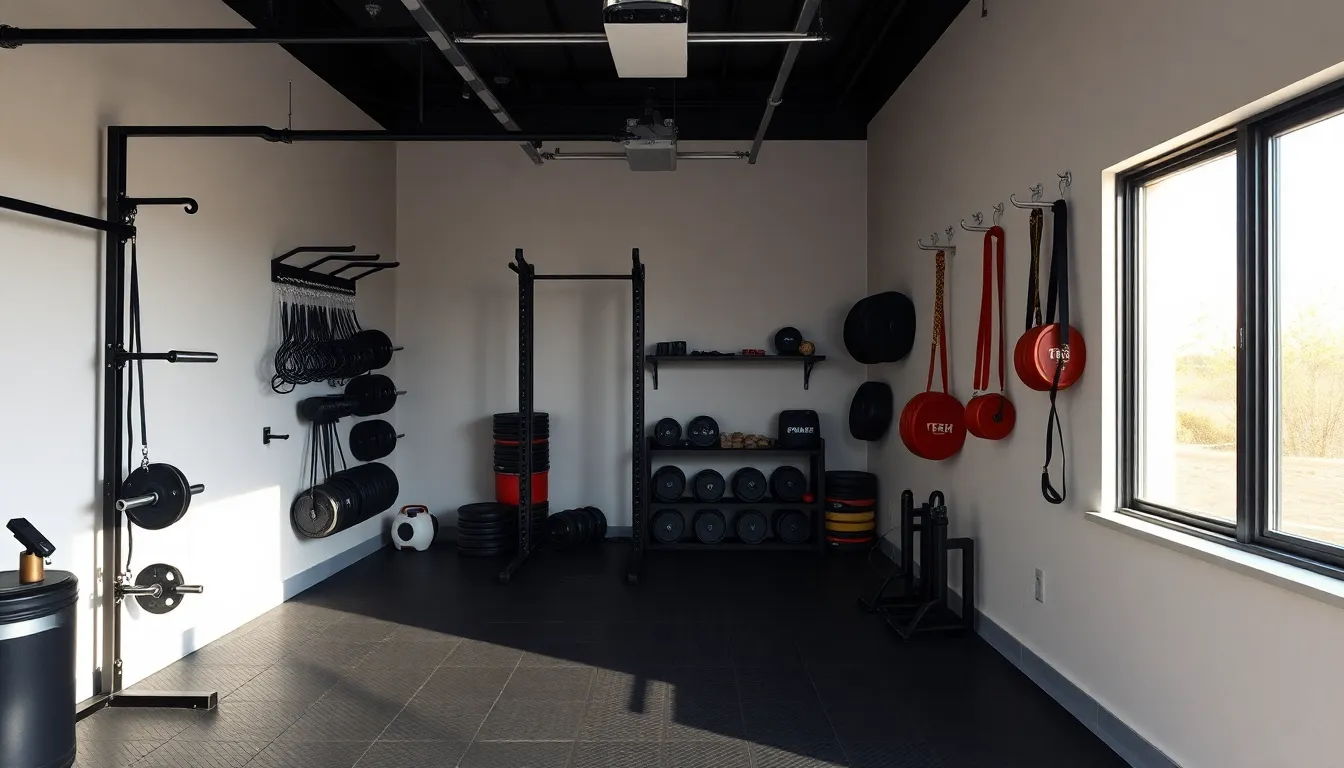
Garages offer exceptional potential for home gym setups because they provide ample space for equipment variety while maintaining flexibility for multiple uses. We’ll explore strategic approaches to maximize your garage space through smart planning and efficient equipment placement.
Flooring and Ventilation Considerations
Rubber mats transform concrete garage floors into workout-friendly surfaces that protect both your equipment and joints during high-intensity exercises. We recommend installing interlocking rubber tiles or rolled rubber flooring that can withstand dropped weights and heavy equipment movement.
Ventilation systems prevent moisture buildup and maintain comfortable workout temperatures throughout the year. Installing ceiling fans or exhaust fans creates proper airflow that reduces humidity and prevents equipment corrosion.
Windows provide natural ventilation when combined with cross-ventilation strategies that draw fresh air through the space. We suggest opening garage doors partially during workouts to create optimal air circulation patterns.
| Flooring Type | Cost Range | Durability | Best For |
|---|---|---|---|
| Rubber Mats | $2-5/sq ft | High | Heavy weights |
| Foam Tiles | $1-3/sq ft | Medium | Light exercises |
| Vinyl Rolls | $1-4/sq ft | High | Multi-purpose |
Heavy Equipment Placement
Power racks require secure floor anchoring to prevent tipping during heavy lifting sessions and ensure user safety throughout workouts. We anchor these units using concrete bolts that distribute weight evenly across the foundation.
Cable machines function best when positioned along garage walls where they won’t interfere with traffic flow or other equipment usage. Strategic placement allows for full range of motion while maximizing available floor space.
Equipment spacing follows the 3-foot rule that provides adequate clearance around each piece for safe movement and exercise execution. We position heavy equipment first, then arrange lighter items around these anchor points.
Weight storage systems mount directly to walls using heavy-duty brackets that keep plates organized and easily accessible during workouts. Wall-mounted barbell racks save floor space while providing secure storage for multiple bars.
Weather Protection Strategies
Insulation installation regulates temperature fluctuations that can make workouts uncomfortable and damage sensitive equipment over time. We recommend foam board or fiberglass insulation for walls and ceiling areas.
Door and window sealing prevents moisture infiltration that leads to rust formation on metal equipment and creates unhealthy workout conditions. Weather stripping around openings creates an effective barrier against external elements.
Dehumidifiers maintain optimal humidity levels between 30-50% that protect equipment while creating comfortable exercise environments. We suggest portable units for smaller spaces or whole-garage systems for larger setups.
Equipment covers protect sensitive electronics like treadmills and exercise bikes from dust and temperature extremes when not in use. Custom-fit covers or tarps provide additional protection during extreme weather conditions.
Basement Home Gym Setup Ideas and Considerations
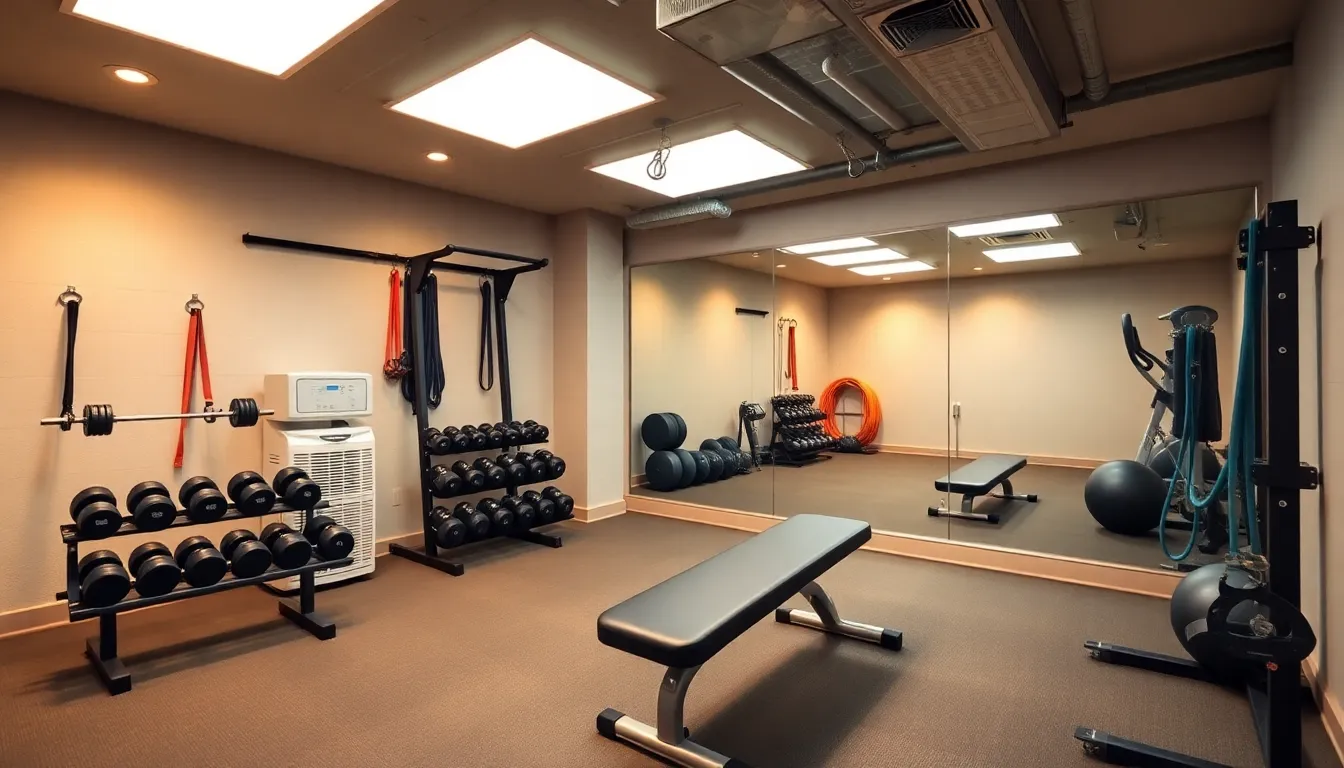
Moving from the garage to below ground level, we’ll explore how basements offer unique advantages for home gym setups while presenting distinct challenges that require careful planning.
Moisture Control and Dehumidification
Basements naturally accumulate moisture that can damage equipment and create uncomfortable workout conditions. We recommend installing a quality dehumidifier as your first priority since high humidity levels can rust metal equipment and promote mold growth on surfaces.
Proper moisture control requires maintaining humidity levels between 30-50% for optimal equipment protection. Dehumidifiers should run continuously during humid seasons to prevent condensation buildup on weights and machines.
Ventilation improvements complement dehumidification efforts by promoting air circulation throughout the space. Installing exhaust fans or improving existing ventilation systems helps remove stale air and moisture naturally.
Waterproofing existing basement walls and floors prevents external moisture from entering your workout space. We suggest sealing any cracks or gaps where water might penetrate before setting up expensive equipment.
Lighting and Electrical Requirements
Adequate lighting transforms dark basement spaces into motivating workout environments that support safe exercise routines. We recommend installing bright LED fixtures that provide at least 50 foot candles of illumination across your entire workout area.
Electrical outlets must accommodate multiple pieces of equipment without overloading circuits or creating safety hazards. Planning outlet placement near equipment locations eliminates the need for extension cords that can create tripping hazards.
Natural light sources should be maximized through window wells or light tubes when possible to reduce dependence on artificial lighting. Adding mirrors strategically reflects available light and creates the illusion of a larger workout space.
Emergency lighting systems ensure you can safely exit the basement during power outages or equipment failures. Battery powered backup lights provide essential safety coverage for stairway access.
Ceiling Height Limitations
Standard basement ceilings typically measure 7-8 feet, which restricts overhead movements and equipment choices significantly. We advise measuring your ceiling height before purchasing equipment to avoid clearance issues with pull up bars or cable machines.
Low profile equipment selections maximize your available space while maintaining exercise effectiveness and safety. Adjustable dumbbells, resistance bands, and compact weight benches work well in spaces with limited vertical clearance.
Overhead exercises require careful consideration of both ceiling height and your personal reach to prevent injury. Pull up bars need adequate clearance above your head, typically requiring 8-9 feet of total ceiling height for safe use.
Equipment placement should account for ever-changing movements that extend beyond static positions during actual workouts. We recommend leaving at least 12 inches of clearance above your tallest exercise position for safety.
Spare Room Home Gym Setup Ideas for Multi-Use Spaces
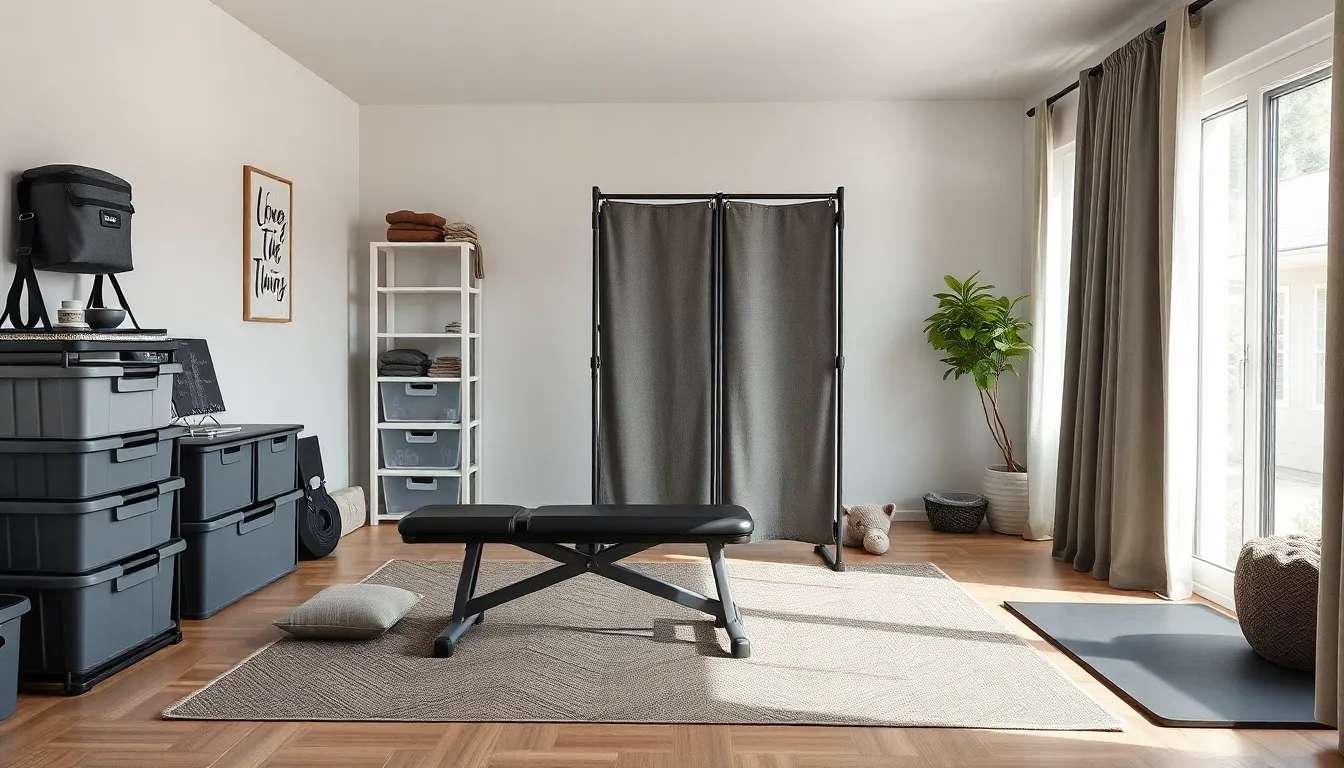
Spare rooms offer exceptional flexibility for creating dual-purpose fitness spaces that adapt to your changing needs throughout the day. We’ll show you how to maximize these versatile areas while maintaining their multi-functional capabilities.
Room Dividers and Privacy Answers
Folding screens create instant separation between workout and living areas without permanent installation. We recommend choosing lightweight panels that store easily in closets when not needed.
Curtain systems offer affordable privacy answers that mount on ceiling tracks for smooth operation. Installing floor-to-ceiling curtains helps define workout zones while maintaining the room’s open feel during non-exercise periods.
Freestanding panels provide sturdy division options that don’t require wall mounting or ceiling installation. These portable answers work especially well in rental properties where permanent modifications aren’t allowed.
Sliding barn doors deliver a modern aesthetic while offering complete room separation when needed. We suggest this option for spaces that frequently transition between home office and gym use.
Bookshelf dividers serve dual purposes by providing equipment storage while creating natural room separation. Strategic placement of tall storage units helps organize gear while maintaining visual boundaries between different activity zones.
Quick Setup and Takedown Systems
Foldable equipment transforms any spare room into a functional gym within minutes of setup time. We prioritize collapsible benches, folding squat racks, and portable cardio machines that store in standard closets.
Wall-mounted storage keeps equipment organized and easily accessible for rapid deployment. Installing pegboard systems or wall racks allows us to grab gear quickly without searching through boxes or containers.
Stackable containers provide organized storage answers that maximize vertical space in closets or corners. We use clear totes labeled by equipment type to identify workout gear at a peek.
Quick-release floor mats snap together and apart in seconds for fast room transitions. These interlocking systems protect flooring during workouts and store compactly when the space serves other purposes.
Mobile storage carts roll equipment between rooms or into storage areas effortlessly. We recommend wheeled units that fit through standard doorways and hold multiple pieces of compact exercise gear.
Noise Reduction Techniques
Thick rubber mats absorb impact noise from dropped weights and high-intensity cardio movements. We install 3/4-inch thickness mats to provide maximum sound dampening for apartment or multi-story living situations.
Acoustic panels minimize sound transmission through walls to adjacent bedrooms or living spaces. Strategic placement on walls behind equipment areas reduces noise complaints from family members or neighbors.
Vibration-dampening pads prevent heavy equipment from transferring movement energy through floors. We place these specialized pads under treadmills, stationary bikes, and weight machines to eliminate structure-borne noise.
Soft furnishings naturally absorb sound waves and reduce echo in spare room environments. Adding curtains, area rugs, and fabric wall hangings helps create a quieter workout atmosphere.
Window treatments block external noise while preventing workout sounds from escaping the room. We recommend heavy curtains or blackout panels that serve dual purposes for both sound control and privacy during exercise sessions.
Outdoor Home Gym Setup Ideas for Fresh Air Workouts
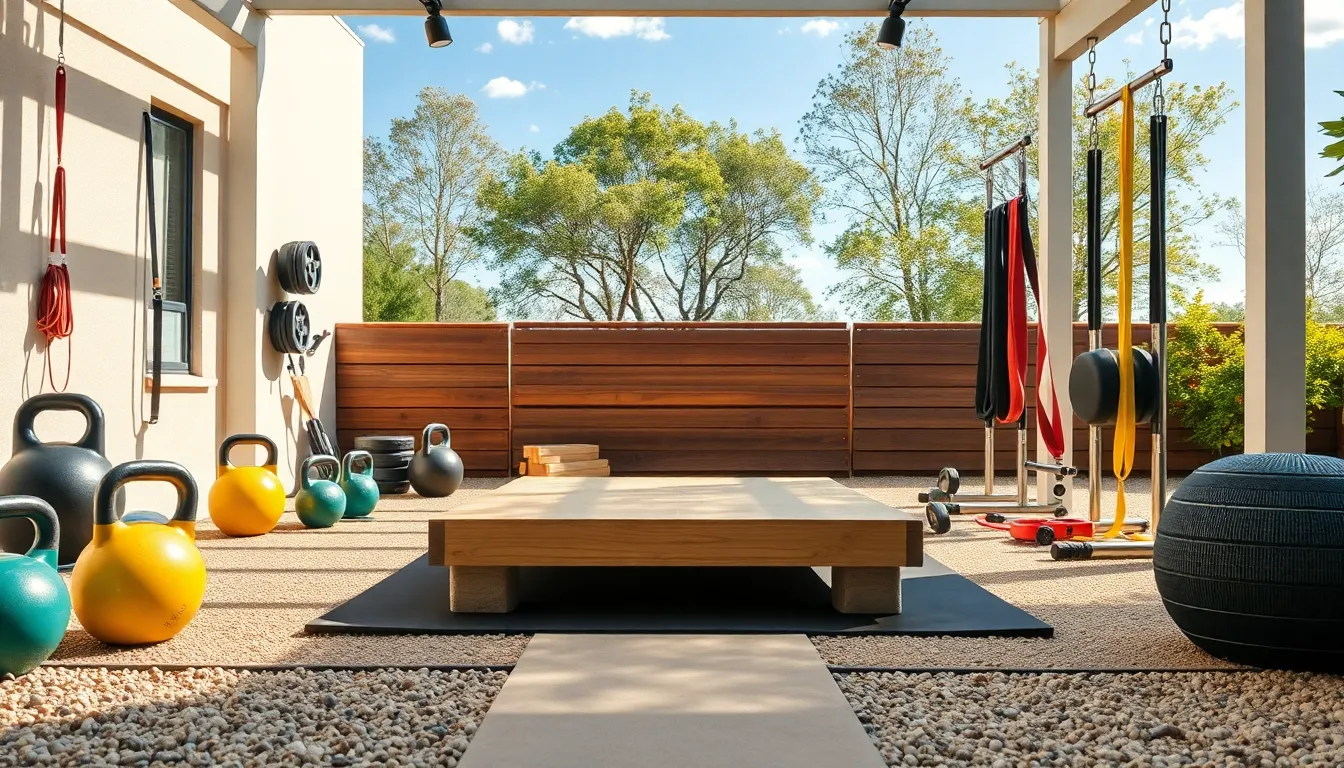
Transitioning our home gym outdoors opens up new possibilities for ever-changing workouts while enjoying natural light and fresh air. Creating an effective outdoor fitness space requires careful consideration of weather conditions and durable equipment selection.
Weather-Resistant Equipment Selection
Multipurpose lifting platforms made from plywood topped with rubber mats provide excellent durability and cushioning for various exercises. These platforms withstand seasonal changes while protecting both our equipment and the ground surface beneath.
Weather-proof gym equipment becomes essential for maintaining consistent workouts throughout the year. We recommend selecting rust-resistant materials like stainless steel, powder-coated finishes, and marine-grade components that can handle rain, humidity, and temperature fluctuations.
Functional fitness equipment such as tires, ropes, and sandbags offers versatility for strength, agility, and coordination training. These items naturally resist weather damage while providing endless workout possibilities for circuit training and high-intensity intervals.
Kettlebells, resistance bands, and free weights designed for outdoor use feature protective coatings that prevent corrosion. Choose equipment with drainage holes or non-porous surfaces that won’t trap moisture during storage.
Ground Surface Preparation
Level surfaces form the foundation of any safe outdoor gym setup, whether using existing decking, concrete slabs, or properly compacted ground. Uneven terrain increases injury risk and limits exercise options, making surface preparation our top priority.
Durable, slip-resistant outdoor gym mats with built-in drainage systems protect both equipment and users during wet conditions. These specialized mats provide cushioning for high-impact exercises while channeling water away from workout areas.
Compacted gravel or decomposed granite creates stable surfaces for heavier equipment installations. We recommend adding a layer of interlocking rubber tiles over these bases for enhanced comfort and equipment protection.
Natural stone or paver pathways work excellently for circuit training stations and agility drills. These materials require minimal maintenance while providing defined workout zones that resist shifting under use.
Seasonal Storage Answers
Weatherproof storage boxes or mini sheds protect valuable equipment from harsh weather conditions between workout sessions. We prioritize containers with tight-fitting lids and ventilation systems that prevent moisture buildup and rust formation.
Canopies and shade sails offer dual protection from intense sun exposure and light rain during workouts. These installations extend our outdoor gym’s usability throughout different seasons while protecting both equipment and users.
Mobile storage carts allow us to quickly move equipment between indoor and outdoor locations based on weather conditions. Choose models with all-weather wheels and lockable compartments for security.
Wall-mounted storage systems on garage exteriors or covered patios keep frequently used items easily accessible. We recommend installing these systems under overhangs or covered areas to maximize protection while maintaining convenience.
Technology Integration for Modern Home Gym Setups
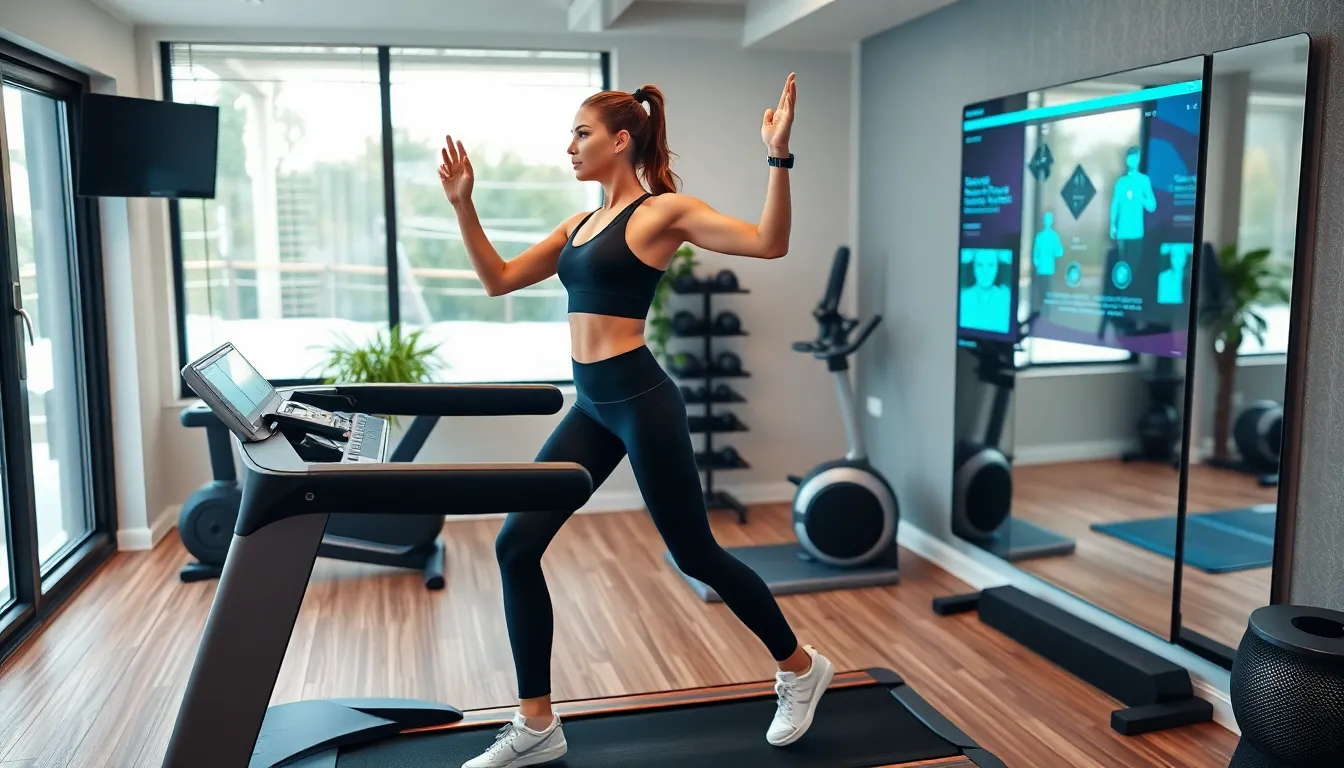
Technology transforms today’s home gyms into connected fitness spaces that rival commercial facilities. Smart devices and digital platforms create captivating workout experiences while tracking progress and maintaining motivation.
Smart Equipment and Connected Devices
Smart home gym equipment revolutionizes how we approach fitness by providing real-time performance tracking and personalized feedback. Connected treadmills, bikes, and strength machines automatically adjust settings based on our goals while monitoring key metrics like heart rate, calories burned, and workout duration.
Peloton equipment stands out for its seamless app integration and comprehensive tracking capabilities. Mirror devices offer interactive workouts with real-time form correction and performance analysis. Echelon products connect multiple users for competitive training sessions and shared progress tracking.
Wearable fitness trackers and smartwatches enhance the connected experience by providing additional health data beyond what machines capture. These devices encourage consistency through goal setting, progress notifications, and achievement badges. Integration between wearables and smart equipment creates comprehensive fitness profiles that adapt workouts to our daily activity levels and recovery status.
Sensors throughout smart equipment capture movement patterns, power output, and technique metrics we can review after each session. This data helps identify areas for improvement and tracks long-term progress trends that keep us motivated.
Virtual Training Platform Options
Virtual training platforms deliver professional instruction directly to our home gyms through live and on-demand workout classes. Peloton offers cycling, running, strength training, and yoga classes with industry-class instructors who provide motivation and technique guidance.
Apple Fitness+ integrates seamlessly with Apple Watch to display real-time metrics during workouts while offering diverse class formats from HIIT to mindfulness. Zwift creates immersive cycling and running experiences through virtual worlds where we can train alongside users worldwide.
Interactive experiences through smart mirrors and screens provide real-time instruction that adapts to our form and pace. Instructors can see our performance data and offer personalized coaching cues during live sessions. Group workouts allow us to participate in challenges with friends and family members regardless of location.
Personalized training programs analyze our fitness history and goals to recommend optimal workout schedules and intensity levels. These platforms learn from our preferences and performance to suggest new class types that align with our interests and fitness development.
Sound System and Entertainment Setup
Quality sound systems enhance motivation and enjoyment during home gym sessions through immersive audio experiences. Bluetooth speakers provide wireless connectivity for streaming music, podcasts, or guided workout audio without cable limitations.
Soundbars deliver theater-quality audio for virtual classes and entertainment content while maintaining clear dialogue and music separation. Built-in audio systems integrate directly into gym equipment for seamless operation without additional devices cluttering our workout space.
Wall-mounted TVs and projectors with streaming capabilities allow access to entertainment, virtual classes, or fitness-exact content during longer cardio sessions. These displays connect to multiple devices simultaneously, enabling quick switching between workout apps and entertainment platforms.
Smart lighting systems sync with our audio setup to create energizing or relaxing ambiance that matches workout intensity. LED lights with adjustable brightness and color temperature help establish the right mood for different types of training sessions.
Climate control integration ensures comfortable temperatures throughout workouts while maintaining optimal air quality. Automated systems adjust ventilation based on room occupancy and activity levels to prevent overheating during intense training sessions.
Safety Considerations for Home Gym Setup Ideas
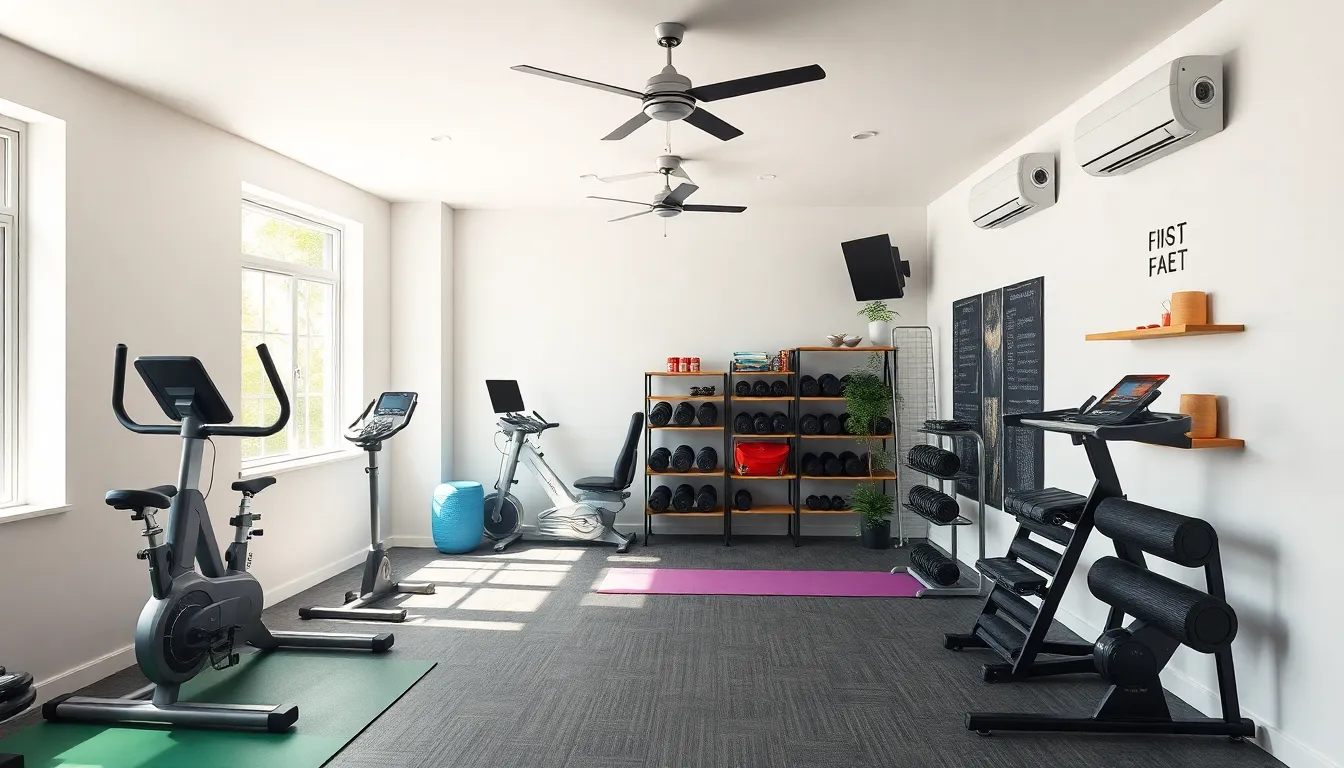
Creating a secure workout environment protects us from injuries and ensures we can maintain our fitness routines without interruption. We need to address several critical safety factors when setting up our home gym space.
Proper Ventilation and Air Quality
Maintaining good airflow prevents overheating and creates a comfortable workout environment. We should install windows, fans, or air conditioning systems to improve circulation throughout our gym space. Proper ventilation helps regulate temperature and removes excess moisture that can lead to mold growth over time.
Cleaning and dusting equipment regularly contributes to better air quality in our workout area. We can prevent the buildup of allergens and maintain a more pleasant exercise environment through consistent maintenance. Fresh air circulation also reduces the concentration of airborne particles that accumulate during intense training sessions.
Temperature control becomes especially important during longer workout sessions when our bodies generate important heat. We should ensure adequate airflow reaches all areas of our gym setup to prevent uncomfortable hot spots. Good ventilation also helps equipment last longer by reducing moisture exposure that can cause rust and deterioration.
Emergency Preparedness and First Aid
Keeping a well-stocked first aid kit within easy reach of our workout area prepares us for minor injuries. We should ensure all household members know the kit’s location and understand basic first aid procedures for common exercise-related injuries. Essential supplies include bandages, antiseptic wipes, ice packs, and pain relievers.
Installing a phone or communication device within our gym space allows us to call for help during emergencies. We need quick access to emergency contacts and medical information in case of serious accidents. Having emergency numbers posted visibly near our workout area saves precious time during critical situations.
Recognizing symptoms of overexertion and dehydration helps us prevent serious health complications during workouts. We should keep water accessible at all times and understand when to stop exercising if we feel dizzy, nauseous, or experience chest pain. Learning proper hydration techniques and rest intervals protects us from heat-related illnesses.
Equipment Maintenance and Inspection
Checking for loose bolts, frayed cables, and damaged parts prevents equipment failures that could cause injuries. We should inspect our gym equipment before each use and address any issues immediately to maintain safe operating conditions. Regular visual inspections help us identify wear patterns and potential problems early.
Following manufacturer guidelines for maintenance schedules ensures our equipment operates safely and efficiently. We need to replace wear components according to recommended timelines and keep maintenance records for warranty purposes. Proper care extends equipment lifespan and reduces the risk of unexpected breakdowns during workouts.
Testing overload protection features on machines verifies they function correctly when equipment reaches its limits. We should clean equipment regularly to prevent sweat and grime buildup that can interfere with moving parts. Lubrication of joints and pivot points keeps equipment operating smoothly and reduces noise levels during use.
Conclusion
Creating your ideal home gym doesn’t have to be overwhelming or expensive. We’ve shown you that whether you’re working with a garage basement spare room or outdoor space there’s a setup that’ll work for your needs and budget.
The key is starting with versatile equipment that serves multiple purposes and gradually building your collection as your fitness journey evolves. Remember that safety and proper maintenance should always be your top priorities.
Your home gym represents freedom from crowded facilities unpredictable schedules and ongoing membership fees. With the right planning and equipment choices you’ll have everything needed to achieve your fitness goals right at home.
Frequently Asked Questions
What are the main benefits of creating a home gym?
Home gyms offer convenience, personalization, and cost savings compared to expensive gym memberships. You can work out anytime without travel time, customize your space and equipment to your preferences, and avoid monthly fees. Home gyms also provide privacy and eliminate waiting for equipment, making it easier to maintain a consistent fitness routine.
How much does it cost to set up a basic home gym?
A functional home gym can be created for under $500 with smart shopping and strategic equipment choices. Basic setups might include resistance bands, adjustable dumbbells, and exercise balls. More premium configurations can cost significantly more, but even budget-friendly options can provide effective full-body workouts when planned correctly.
What essential equipment should I prioritize for my home gym?
Start with versatile, multi-functional equipment: adjustable dumbbells for strength training, resistance bands for targeted muscle work, kettlebells for functional movements, and a pull-up bar for upper body exercises. These items provide maximum workout variety while minimizing space requirements and initial investment costs.
Can I create a home gym in a small space?
Yes, small spaces can accommodate effective home gyms through strategic planning and compact equipment choices. Focus on foldable items like adjustable benches, wall-mounted storage systems, resistance bands, and multi-purpose furniture. Vertical storage solutions and equipment that serves multiple functions help maximize limited square footage.
What’s the best room in my house for a home gym?
Popular options include garages (spacious with ventilation), basements (private and temperature-controlled), spare bedrooms (convenient and multi-use), and even outdoor spaces. Each has unique advantages: garages offer space for heavy equipment, basements provide privacy, and spare rooms allow easy integration with daily routines.
How do I ensure proper ventilation in my home gym?
Install adequate airflow systems including ceiling fans, exhaust fans, or air conditioning. Open windows when possible, and consider dehumidifiers for moisture control, especially in basements. Proper ventilation prevents equipment rust, reduces odors, maintains comfortable temperatures, and improves air quality during intense workouts.
What flooring is best for a home gym?
Rubber mats are ideal for protecting both equipment and joints while providing slip resistance. They’re easy to clean, durable, and help reduce noise transmission. For heavy equipment areas, consider interlocking rubber tiles or specialized gym flooring that can handle dropped weights and high-impact exercises.
How can I find affordable home gym equipment?
Shop second-hand through local classifieds, garage sales, and online fitness forums. Consider DIY alternatives like water bottles for light weights or stairs for cardio. Look for end-of-season sales, buy versatile equipment that serves multiple purposes, and prioritize quality used items over cheap new equipment.
What technology can enhance my home gym experience?
Smart equipment with performance tracking, virtual training platforms like Peloton or Apple Fitness+, and wearable fitness trackers can improve motivation and results. Quality sound systems, wall-mounted TVs, and smart mirrors for interactive workouts also enhance the experience while providing professional instruction at home.
What safety considerations should I keep in mind?
Ensure proper equipment anchoring for heavy items, maintain clear pathways, and regularly inspect equipment for wear. Keep a first aid kit accessible, ensure good lighting, and have communication devices nearby. Follow manufacturer maintenance guidelines and consider professional installation for complex equipment like power racks.

